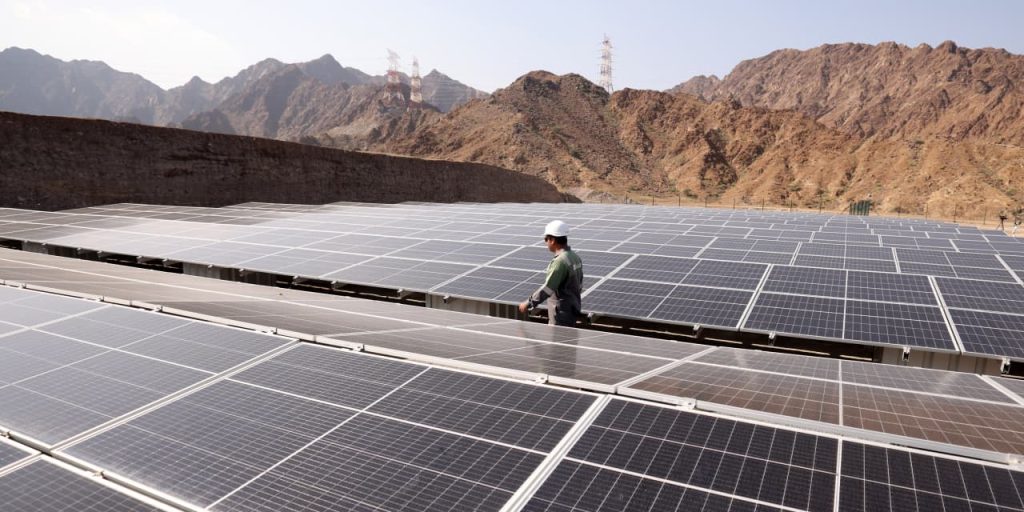The renewable energy industry has benefited from rising demand and investment this year, with strength in the sector led by the solar market, according to Deloitte’s 2024 renewable energy industry outlook report released Tuesday.
Wind power generation, however, struggled in part due to cost pressures, the report said.
Solar is the “most flexible renewable resource,” said Marlene Motyka, U.S. renewable energy leader and principal at Deloitte, pointing out that it can be deployed more quickly, across more states, and at different scales — at the residential, commercial or utility levels. It also faces lower community opposition.
““In 2023, we saw the solar market brighten, and we expect this to continue in 2024.””
“In 2023, we saw the solar market brighten, and we expect this to continue in 2024,” she told MarketWatch.
U.S. utility-scale solar capacity additions rose by 36% in the first eight months of this year, compared to the same period last year, outpacing additions from other power-generation sources, the report said, citing data from the U.S. Federal Energy Regulatory Commission.
The report also pointed out that the Energy Information Administration sees utility-scale solar installations more than doubling this year compared with last year, to a “record-breaking” 24 gigawatts.
Deloitte expects solar to “continue leading the charge on renewable energy,” said Motyka.
In its report, Deloitte said the “tandem push” of federal investments into clean energy and the pull of decarbonization demand for public and private entities have “never been stronger.”
Electricity generation
Renewable energy’s share of U.S. electricity generation is forecast at 22% this year, and is expected to rise to 24% in 2024, with much of the increase due to new solar-generating capacity entering service in 2023 and 2024, according to the EIA.
“The impact of unprecedented investment in renewable infrastructure will likely become more apparent in 2024,” the Deloitte report said.
The Infrastructure Investment and Jobs Act of 2021 (IIJA) and the Inflation Reduction Act (IRA) of 2022 have helped to “catalyze” $227 billion in public and private investment in utility-scale solar, storage, wind and hydrogen, it said.
Challenges remain
Still, wind investment is down 35% over the past year as projects “bore the brunt of headwinds” from higher costs and permitting challenges, which Deloitte survey respondents identified as the “most significant constraints on renewables.”
Transmission issues mark another challenge for renewable energy.
Respondents of the Deloitte 2023 power and utilities industry survey said capturing the full customer benefit of low-cost renewables “hinges on transmission.”
The programs tied to the IIJA and IRA, including the Energy Department’s plan to accelerate high-voltage transmission line permitting, could start to tackle transmission issues next year, Deloitte’s report said.
To sustain a record buildout of renewables and domestic supply chain will “require growing and (re)training a workforce with the right skills in the right places,” it said. It pointed out that over the past two years, clean-energy jobs have grown 10% — a faster pace than overall U.S. employment.
Meanwhile, renewables have often outshined conventional power sources, generating electricity even as those conventional power sources could not, as the “frequency and intensity of extreme weather events, outages and potential electricity supply shortages rise,” the report said.
Still, more of the respondents of the Deloitte survey were concerned about the “resilience of renewables.” Renewable energy ranked the lowest among survey respondents when to comes to being resilient to extreme weather events in their territory, the report said.
Opportunity ahead
Looking ahead, Motyka said Deloitte sees opportunities in “established” renewables, such as solar, wind and energy storage, but also in offshore wind, green hydrogen, enhanced geothermal systems and new feedstocks and end uses for renewable natural gas (RNG). RNG is considered carbon-neutral, consisting largely of methane, which comes from the decomposition of organic matter, according to Southern California Gas Co.
The renewable energy industry in 2024 could “expect to see the historic climate legislation take greater effect” as tax-credit guidance is finalized, more loans from the U.S. Energy Department’s Loan Programs Office are issued, and more programs release IRA grant funding, the Deloitte report said.
“We need a diverse variety of solutions and a broader set than we currently have,” said Motyka. “The pace of scaling and the total capacity each solution offers will be crucial.”
“Immediate progress is imperative to meet decarbonization goals” and that necessitates a variety of solutions, she said. “We’re excited to see more concepts coming forward, and believe that this multi-pronged approach will be necessary to make meaningful progress.”
Read the full article here



